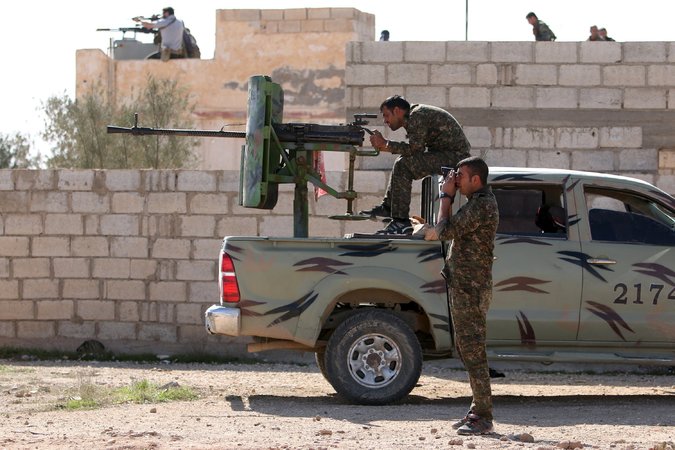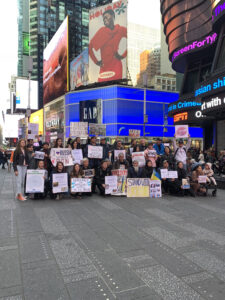Peace in Syria? Don’t Hold Your Breath

Fighters with the Syrian Democratic Forces, part of the coalition combating the Islamic State, on the outskirts of the eastern city of Shadadi. Picture by Rodi Said | Reuters
Fighters with the Syrian Democratic Forces, part of the coalition combating the Islamic State, on the outskirts of the eastern city of Shadadi. Picture by Rodi Said | Reuters
On Feb. 11 news broke of a potential breakthrough in the Syrian Civil War. Russian-backed pro-Assad forces and an umbrella group of U.S.-backed anti-regime rebels agreed to a “cessation of hostilities.” Though this may sound like peace in the region is close at hand, we should not hold our breath. There is little chance that this truce will be observed, and even if it is, it will not change the overall trajectory of the conflict.
The challenges to this peace effort, which is not much more than a truce, may prove insurmountable. The truce relies on the assumption that Russia can urge regime forces to stop fighting and that the United States can do the same for the rebels. But the anti-Assad groups, represented by the High Negotiations Committee (HNC), are not a monolithic faction that will easily ally with the United States. Many rebels feel abandoned by the United States, which has hesitated to provide robust military or diplomatic support to anti-Assad rebels .
Russia and its recent inroads in Syria also represent a major challenge to achieving peace in the region. Since September, Russia has waged a bombing campaign in Western Syria, allowing regime forces backed by Hezbollah and Iran to turn the tide of the war in Assad’s favor. Aleppo, the rebel’s last stronghold, is bracing for a regime offensive. Why would Russia honor a ceasefire when their campaign has been so successful? There is no incentive to stop the fighting on their side. Monitors have already reported violations of the truce, with suspected Russian warplanes hitting rebel-held areas in northern Syria.
The problematic definition of what constitutes terrorism is also standing in the way—creating a loophole in the agreement. This U.S.-Russian-brokered truce only applies to fighting between Assad’s forces and the rebels under the HNC. The agreement does not include those groups fighting Assad that the U.S. State Department has designated as a terrorist organization. Rebels fear this will be a pretext that allows Assad’s forces to keep fighting those groups and not be in violation of the ceasefire. The only groups all parties agree are terrorists are ISIS and Al-Nusra, Al Qaeda’s Syrian branch. Assad considers all his opponents terrorists while the United States, Saudi Arabia, and Turkey support many of these anti-Assad groups. Who is or isn’t a terrorist depends on who you ask. This ambiguity guarantees fighting will continue.
More broadly, this peace plan misses the point when it comes to Syria, as it simplifies the war to a conflict only between Assad and his opponents. A ceasefire is not a bad idea but it will not have a big impact now—it’s 5 years too late. The war began in 2011 as revolution against the Assad regime, but the country has become an arena for some of the Middle East’s most contentious struggles. Outside forces have entered the conflict, changing its dynamic and exacerbating the violence. Puritan militant groups like ISIS have used Syria to build their “Caliphate”; Turkey has used it as a pretext for renewed violence against the Kurds. Russia, seeking to reassert itself in the Middle East at the United State’s expense, has shown its willingness to intensify the bloodshed. Meanwhile Saudi Arabia and Iran have turned their Cold War into a hot one in Syria.
This U.S.-Russian-led proposal is misguided because it places the onus for peace on a select group of rebels and the Assad regime. The war in Syria is no longer just a conflict between those for and against Assad. Outside forces have inserted themselves and their agendas into this civil war. The conflict has been woven into the fabric of religious and political struggles that are a fact of life in the modern Middle East. The Saudi and Iranian seems poised to continue for decades, which means that their proxy war will keep fueling violence in Syria. ISIS has taken a foothold in Syria and given the prevalence of sectarian tensions throughout the region, it will continue its religious crusade. Turkey considers the Kurdish groups in Syria to be terrorists and will likely continue fighting there as part of its campaign against the Kurds. As long as these larger political and religious conflicts persist, so will the fighting in Syria.
A recent op-ed called this ceasefire “pure fantasy,” but the problems go beyond the chances of this truce between pro- and anti-Assad forces being implemented. This deal is understood to be the first step in a process that will eventually see pro-Assad forces and rebels join forces to take back Syria. There is little prospect of this working out. The protracted and barbaric nature of the fighting, now in its fifth year, seems to have taken the warring factions passed the point of reconciliation.
The world has allowed for this civil war to go beyond just a struggle over Assad’s control of Syria. The conflict is being fueled by the destructive policies of several factions using the Syrian Civil War as a vehicle for their political struggles. The United States, Russia, and others inflaming the conflict need to stop considering what Syrians should do differently, and rather, what these countries can do to stop the violence. This U.S.-Russian peace, even if it holds, will not pave the way for a better tomorrow in Syria.
Karim Dewidar is a graduate student in NYU’s International Relations program and a staff writer for JPI. His research interests are: American foreign policy, Chinese political economy, and Middle Eastern affairs. If you have questions, comments, or want to continue the conversation I can be reached at kgd235 [at] nyu [dot] edu







